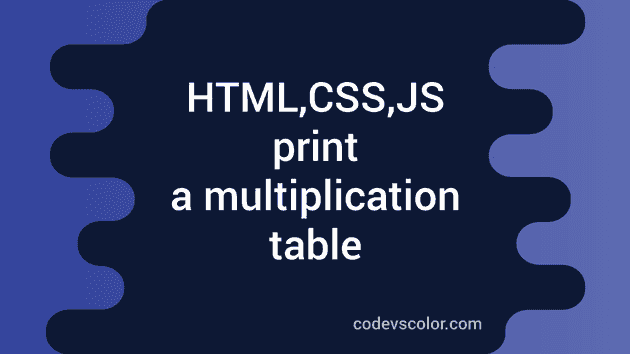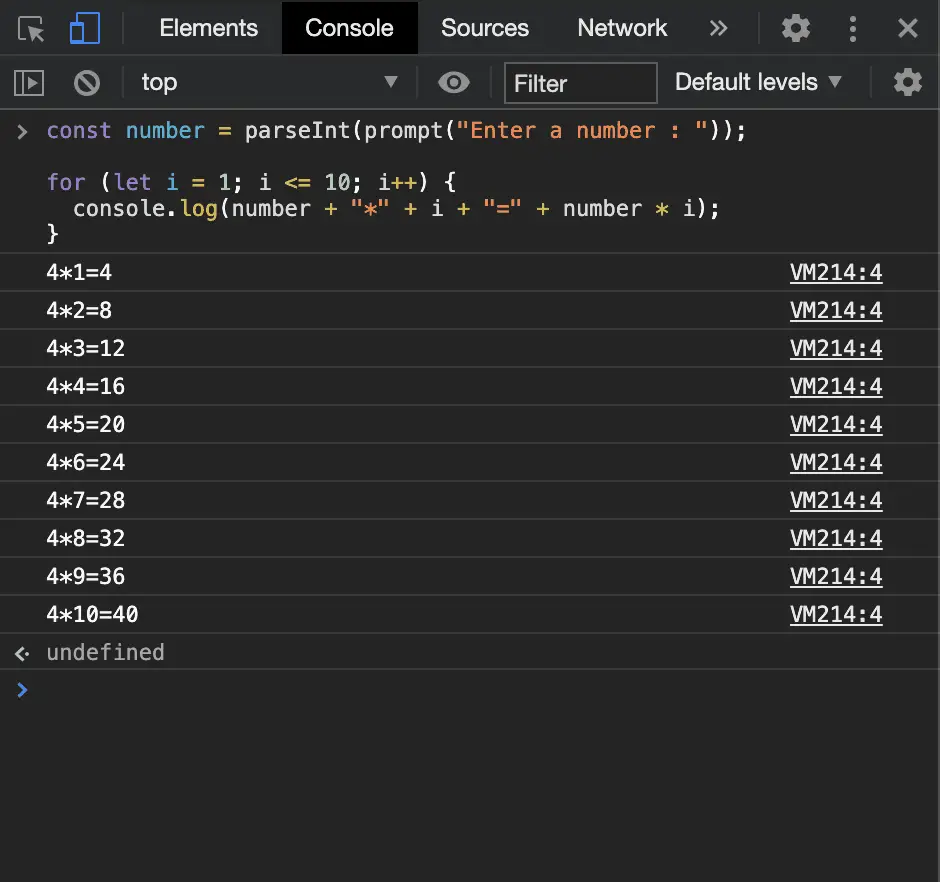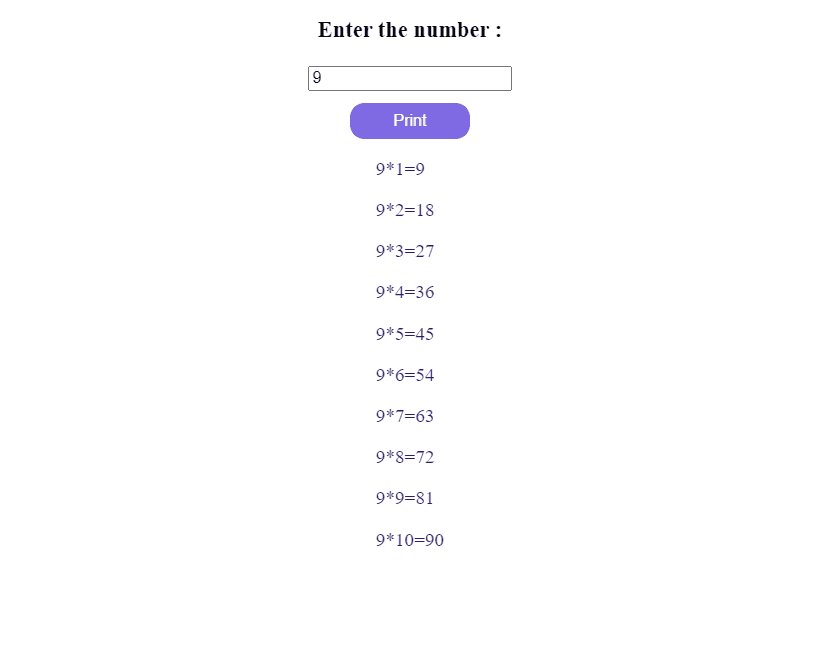How to print a multiplication table in HTML, CSS, and JavaScript:
In this post, we will learn how to print a multiplication table in HTML, CSS and JavaScript. Before writing the HTML, and CSS files, I will show you how to write the program in pure JavaScript. Then we will migrate the code to HTML and CSS and check how it looks on a browser.
Method 1: JavaScript program to print a multiplication table using for loop:
Let’s write the program first using JavaScript:
const number = parseInt(prompt("Enter a number : "));
for (let i = 1; i <= 10; i++) {
console.log(number + "*" + i + "=" + number * i);
}To run this program, open your developer console and paste the above program. It will ask you to enter a number with a popup. Enter the number and it will print the multiplication table for that number.
In this program, we are using a for loop to print the table. The syntax of a for loop is:
for(init; condition; end){
//body
}- The
initblock is executed only once. This is used to initialize a variable. - The
conditionblock is used to add a condition. The loop will keep running until theconditionis true. - The
endblock is used to change the current value of the variable used in theconditionblock. This block is executed at the end of each execution of the loop.
In the above program, we have initialized the value of the variable i as 1 in the init block. The loop will keep running until the value of i is less than or equal to 10. At the end of each iteration, the value of i is incremented by 1.
We are using the value of i in the body of the loop to print the multiplication table for the given number.
Using HTML, CSS with JavaScript and for loop:
Let’s use HTML and CSS with JavaScript to print the multiplication table. We will use a for loop as discussed above to print the multiplication table for a given number.
You need to create one html file to run it. Create one example.html file and copy-paste the below code snippet:
<!DOCTYPE html>
<html lang="en">
<head>
<style>
body {
display:flex;
flex-direction: column;
align-items: center;
}
button {
background-color: #806ae4;
border: none;
color: white;
padding: 15px 15px;
text-decoration: none;
cursor: pointer;
border-radius: 12px;
width: 100px;
margin-top: 10px;
height: 30px;
line-height: 0;
}
p{
color: #27186b;
}
</style>
<script>
function addNumbers() {
var number;
var result = "";
number = Number(document.getElementById("number").value);
for(var i = 1; i<= 10; i++){
result = result + "<p>"+number + "*" + i + "=" + number * i+"</p>";
}
document.getElementById("result").innerHTML = result;
}
</script>
</head>
<body>
<h3>Enter the number : </h3>
<input id="number" />
<button onclick="addNumbers()">Print</button>
<div id="result">
</body>
</html>Open that file in your browser. It will look as below:
In this example,
- The
styleblock includes the CSS styles and thescriptblock includes the JavaScript code. - Inside the
<body></body>, we have one<input/>field to take the number as input from the user. One button is also there to invoke theaddNumbersfunction in JavaScript if the user clicks on it. See, how easy it is to run JavaScript from HTML !! - Inside the
addNumbersfunction, we are adding all lines of the multiplication table to a variableresult. Each line is wrapped in a<p>...</p>tag. - Once the loop is executed, we are accessing the element with id
resultin the HTML file, which is a<div>in the<body/>. We are changing theinnerHTMLproperty to display the table in the<div>.
Method 2: JavaScript program to print a multiplication table using a while loop:
Similar to the for loop, we can also use a while loop to print a multiplication table. The syntax of a while loop is:
while(condition){
//body
}It will keep running the body of the loop until the condition is true. We can add the end statement of the for-loop at the end of the while loop body. If I write the above program with a while loop, it will be:
const number = parseInt(prompt("Enter a number : "));
let i = 1;
while (i <= 10) {
console.log(number + "*" + i + "=" + number * i);
i++;
}- The variable
iis initialized before the loop starts. - It will run until its value is less than or equal to 10.
- At the end of each iteration, it increments the value of
iby 1.
Print the multiplication table in HTML, CSS, and JavaScript with while-loop:
We can change the above HTML code to use a while loop as below:
<!DOCTYPE html>
<html lang="en">
<head>
<style>
body {
display:flex;
flex-direction: column;
align-items: center;
}
button {
background-color: #806ae4;
border: none;
color: white;
padding: 15px 15px;
text-decoration: none;
cursor: pointer;
border-radius: 12px;
width: 100px;
margin-top: 10px;
height: 30px;
line-height: 0;
}
p{
color: #27186b;
}
</style>
<script>
function addNumbers() {
var number;
var result = "";
number = Number(document.getElementById("number").value);
var i = 1;
while(i<= 10){
result = result + "<p>"+number + "*" + i + "=" + number * i+"</p>";
i++;
}
document.getElementById("result").innerHTML = result;
}
</script>
</head>
<body>
<h3>Enter the number : </h3>
<input id="number" />
<button onclick="addNumbers()">Print</button>
<div id="result">
</body>
</html>It will give similar results.
Method 3: By using a do-while loop:
The do-while loop is similar to the while loop. Its syntax is:
do{
//body
}while(condition);It executes the body and checks for the condition after each execution. We can use it as below:
const number = parseInt(prompt("Enter a number : "));
let i = 1;
do {
console.log(number + "*" + i + "=" + number * i);
i++;
}while (i <= 10);Similarly, we can use it with HTML, CSS and JavaScript:
<!DOCTYPE html>
<html lang="en">
<head>
<style>
body {
display:flex;
flex-direction: column;
align-items: center;
}
button {
background-color: #806ae4;
border: none;
color: white;
padding: 15px 15px;
text-decoration: none;
cursor: pointer;
border-radius: 12px;
width: 100px;
margin-top: 10px;
height: 30px;
line-height: 0;
}
p{
color: #27186b;
}
</style>
<script>
function addNumbers() {
var number;
var result = "";
number = Number(document.getElementById("number").value);
var i = 1;
do{
result = result + "<p>"+number + "*" + i + "=" + number * i+"</p>";
i++;
}while(i<= 10);
document.getElementById("result").innerHTML = result;
}
</script>
</head>
<body>
<h3>Enter the number : </h3>
<input id="number" />
<button onclick="addNumbers()">Print</button>
<div id="result">
</body>
</html>You might also like:
- 2 different JavaScript programs to count the number of digits in a string
- 3 JavaScript programs to get the first character of each words in a string
- 2 different JavaScript methods to remove first n characters from a string
- 2 different JavaScript program to remove last n characters from a string
- JavaScript program to add two numbers - 3 different ways
- 2 different JavaScript program to calculate age from date of birth



